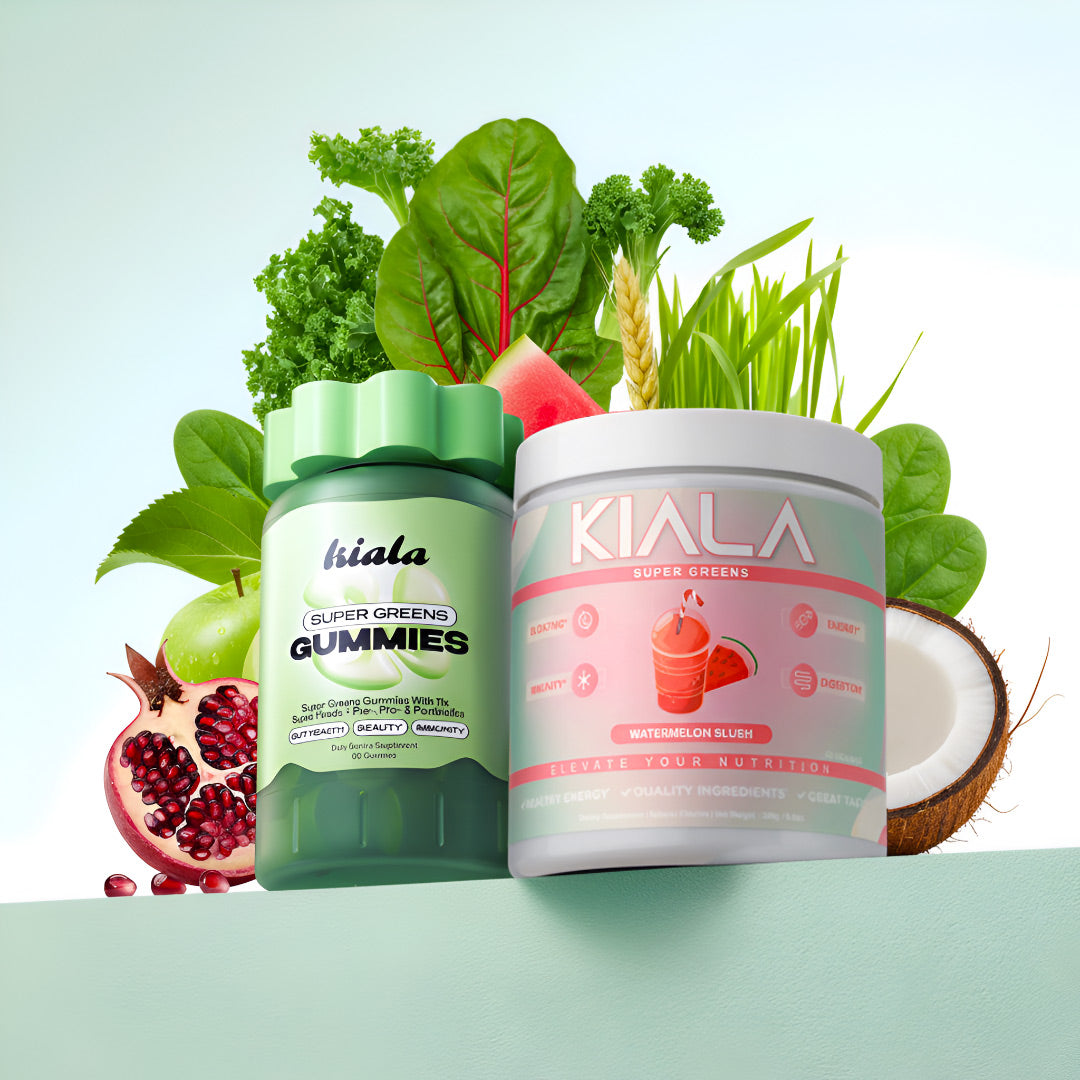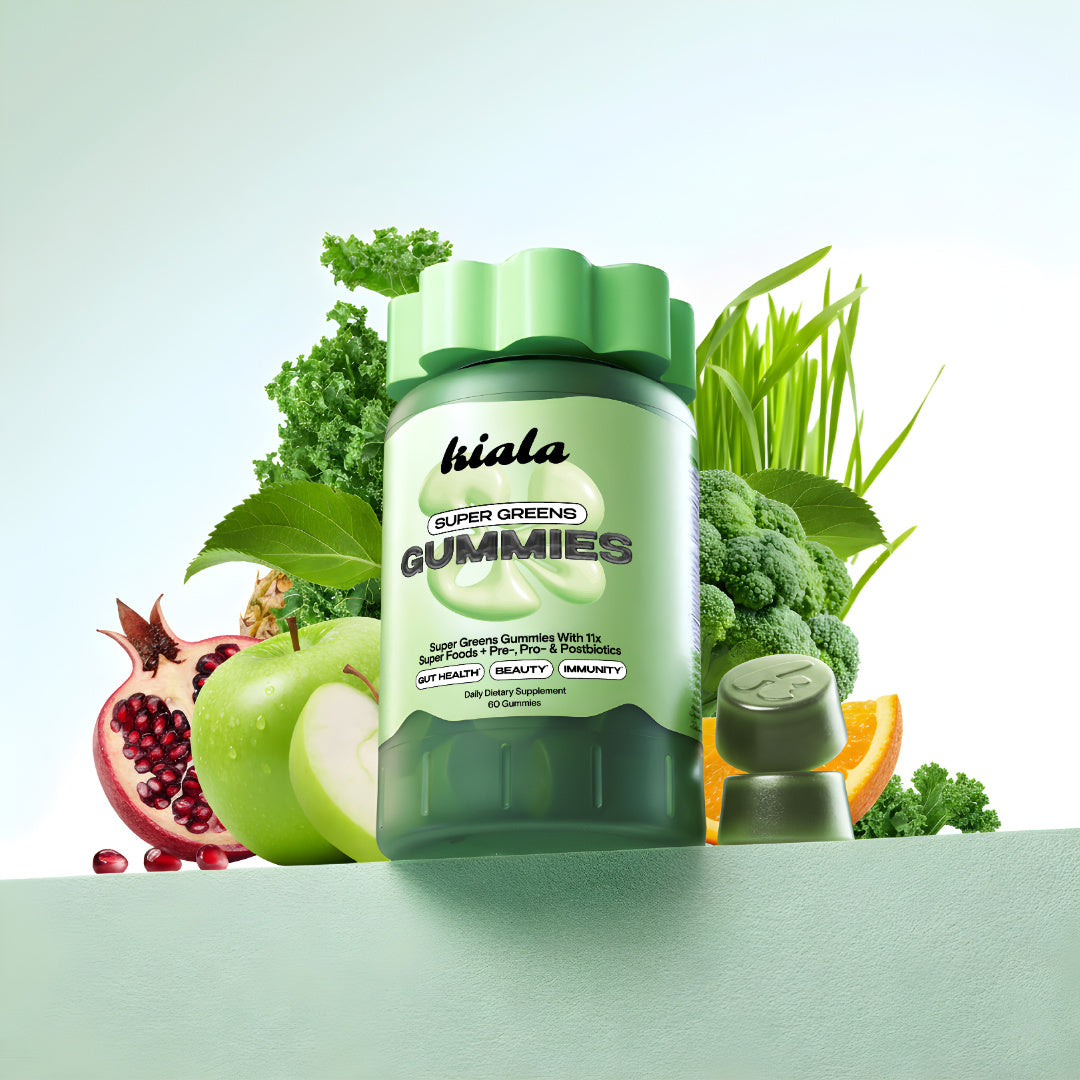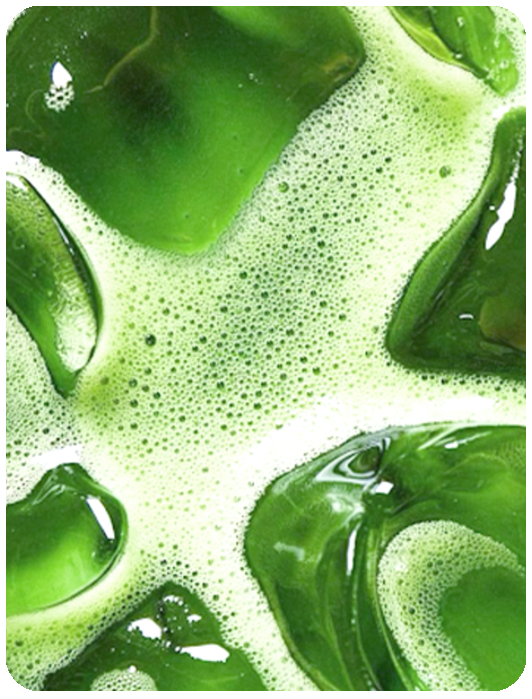Two years of development. And I can say with confidence: this is the most sophisticated formulation we've ever brought to market.
Let me be direct: we didn't create gummies because they're trending. We created them because the feedback from our community was consistent and specific—you needed something that addressed the variable most wellness products ignore.
The Feedback That Shaped Development
After our Super Greens powder achieved category dominance—becoming the #1 greens brand on TikTok and a best seller on Amazon—we analyzed thousands of customer communications. The pattern was unmistakable: you weren't requesting flavor variations or serving size modifications.
You were requesting functional complementarity. Something portable. Something that addressed the aspects our powder doesn't target.
The unmet need was clear: comprehensive gut health support was missing from the equation.
The Gut Health Crisis Nobody's Addressing
Here's what we kept hearing: bloating that persists throughout the afternoon. Digestive discomfort that disrupts daily function. That persistent heaviness that doesn't respond to dietary interventions.
The epidemiological data validates these reports. Nearly 1 in 7 Americans experience bloating on a weekly basis, according to a 2022 national survey of 88,795 people published in Clinical Gastroenterology and Hepatology. More significantly: women are more than twice as likely as men to report bloating—and 58.5% never seek professional care for it.
A global epidemiology study spanning 26 countries found that 18% of the worldwide population experiences bloating at least weekly, with women approximately twice as likely to suffer from this symptom compared to men. The prevalence peaks among women ages 40-59, precisely when metabolic and hormonal transitions make gut health most critical.
But the gut microbiome's influence extends far beyond bloating. Research published in Gut Microbes (2022) demonstrates that the gut is a primary regulator of metabolism, immunity, dermatological health, energy production, and neurotransmitter synthesis. When the relationship between gut microbiome and the immune system is impaired, downstream effects can be triggered systemically, potentially promoting inflammatory conditions throughout the body.
Dr. Giada De Palma, leading microbiome researcher at McMaster University, explains: "The gut microbiome plays a significant role in maintaining gut-skin homeostasis. The mechanisms through which the gut microbiome affects skin health include modulation of inflammatory responses, gut barrier integrity, and systemic signaling pathways."
You can optimize macronutrient intake and micronutrient supplementation, but if gut barrier function is compromised and microbial diversity is depleted, nutrient absorption and utilization are fundamentally impaired. This is the variable most wellness protocols ignore.
Why Two Years? Standards Over Speed
When you have market momentum, the conventional strategy is rapid product expansion. Launch quickly. Capitalize on brand awareness. Maintain velocity.
We made a different calculation.
The distinction between products that generate revenue and products that deliver measurable outcomes is significant. The supplement industry has an abundance of the former. Our thesis depends on the latter.
The timeline reflected the complexity of the formulation challenge.
The Innovation: Mechanistic Formulation Design
We partnered with Dr. Holly Lofton, Director of the Weight Management Program at NYU Langone Health, along with specialized nutrition formulators and research scientists. The objective was technically demanding: create the most efficacious gut health delivery system in gummy format—one that demonstrates measurable cellular effects while maintaining palatability sufficient for long-term compliance.
Most supplement brands optimize for either efficacy or taste, treating them as mutually exclusive. We rejected that constraint as a formulation failure, not an inherent limitation.
The Triple-Biotic Formulation Strategy
The core innovation in Super Greens Gummies is what we're calling a "triple-biotic approach"—the strategic combination of prebiotics, probiotics, and postbiotics to address gut health through complementary mechanisms of action.
Prebiotics serve as selective substrate for beneficial bacteria. We included chicory root-derived fructooligosaccharides (FOS) that specifically promote the growth of Bifidobacterium and Lactobacillus species, increasing microbial diversity and metabolite production.
Probiotics introduce functional microbial strains to modulate gut microbiome composition. We selected Bacillus coagulans SNZ 1969™ based on its spore-forming characteristics and extensive clinical validation across 30+ studies and five decades of documented use.
This strain is different. A 2022 randomized, placebo-controlled study published in the International Journal of Health Sciences and Research found that SNZ 1969 significantly reduced gastrointestinal discomfort, with notable improvements in bloating symptoms, nonpain symptoms, and satisfaction scores compared to placebo—and these improvements were sustained even after treatment discontinuation.
But what makes SNZ 1969 truly remarkable is its survival ability. Research published in Food Research International (2021) demonstrated that this spore-forming strain reaches the colon intact and ameliorates intestinal motility. In an 8-week clinical trial with adults experiencing mild intermittent constipation, SNZ 1969 supplementation significantly improved colonic transit time (p = 0.031), complete spontaneous bowel movements, and bowel discomfort scores—all while positively altering gut microbiome composition.
We also included Lactobacillus plantarum Immune LP20®, a heat-killed postbiotic strain with powerful immunomodulatory properties. A 12-week randomized, double-blind, placebo-controlled study published in the British Journal of Nutrition (2014) found that daily intake of this heat-killed L. plantarum strain significantly decreased upper respiratory tract infection incidence in healthy subjects with high stress levels. The mechanism? Enhanced concanavalin A-induced proliferation of peripheral blood mononuclear cells and augmented immune functions.
The heat treatment actually makes this strain more stable and bioavailable—it doesn't need to "survive" your stomach because it works through its cellular components and metabolites.
Postbiotics represent an emerging category in microbiome science. As defined by the International Scientific Association for Probiotics and Prebiotics (ISAPP), postbiotics are "preparations of inanimate microorganisms and/or their components that confer a health benefit on the host."
A 2024 review in Cell Metabolism highlights that postbiotics offer antioxidant activity, immunomodulatory effects, gut microbiota modulation, and enhancement of epithelial barrier function—with the added advantages of stability, safety, and no viability concerns compared to live probiotics. Research published in Probiotics and Antimicrobial Proteins (2023) shows that postbiotics support intestinal tissue repair, promote healthy gut barrier integrity, and modulate immune responses without the risks associated with live microorganisms.
By including postbiotics, we're delivering preformed metabolites and bioactive cellular components that support gut barrier function and immune regulation—independent of microbial colonization.
This three-component strategy addresses gut health through substrate provision (prebiotics), microbial modulation (probiotics), and direct metabolite delivery (postbiotics)—a more comprehensive approach than single-mechanism interventions.
The Superfoods That Actually Matter
We packed in 11 organic greens and superfoods at 300mg per serving, but we were incredibly strategic about which ones made the cut:
Organic Kale, Spinach, and Broccoli—the cruciferous powerhouses delivering glucosinolates, vitamins K and C, and folate in their most bioavailable forms. Research consistently shows cruciferous vegetables support detoxification pathways and provide compounds with anti-inflammatory properties.
Organic Alfalfa powder—a nutrient-dense botanical rich in vitamins, minerals, and chlorophyll that's been used traditionally for centuries.
Turmeric root extract—standardized for curcuminoids, the natural anti-inflammatory compounds that have been extensively studied for their effects on inflammatory pathways, joint comfort, and cellular health. The anti-inflammatory mechanisms of curcumin have been documented in hundreds of peer-reviewed studies.
Elderberry fruit extract and Tart cherry extract powder—delivering anthocyanins and polyphenols with potent antioxidant properties. Elderberry has been studied for immune support, while tart cherry's anthocyanins have been researched for their effects on oxidative stress and recovery.
Organic Beet root powder—a source of dietary nitrates that the body converts to nitric oxide, supporting healthy circulation and cardiovascular function. Research published in journals like Hypertension has documented beet root's effects on blood flow and endothelial function.
Organic Acerola juice powder—one of nature's richest sources of natural vitamin C, providing far more ascorbic acid per gram than oranges, supporting collagen synthesis and immune function.
Organic Cranberry fruit powder—known for its proanthocyanidins (PACs) that support urinary tract health and provide additional antioxidant capacity.
Ginger root extract—containing gingerols and shogaols that have been studied extensively for their effects on nausea, digestive comfort, and inflammatory response.
Every ingredient was selected based on published research and functional benefits, not marketing trends. We didn't add things because they're popular—we added them because the mechanistic and clinical data support their inclusion.
The Palatability Challenge
With this ingredient density and bioactive load, the formulation path of least resistance would involve high sugar content to mask botanical bitterness.
That approach compromises the metabolic benefits we're trying to achieve.
Zero sugar. Let me repeat: zero sugar. Just 20 calories per serving with only 3g of naturally occurring sugars from the fruit and vegetable ingredients themselves.
But here's what makes this remarkable: they actually taste incredible. We went through 47 iterations to achieve a flavor profile that makes compliance effortless. Because flavor is part of the ritual, and the ritual determines adherence—which determines results.
The Science of the Gut-Metabolism-Skin Axis
The emerging research here is compelling. Your gut health determines far more than digestion—it's a primary regulator of metabolic function and dermatological outcomes.
A 2023 review in Nature Reviews Microbiology titled "Roles of the gut microbiome in weight management" details how the gut microbiome profoundly impacts energy balance through diverse mechanisms affecting both energy intake and expenditure. The gut microbiota directly influences digestion, absorption, and metabolism of food, while also modulating appetite, bile acid metabolism, and hormonal signaling.
Dr. Rachel Carmody, Harvard Department of Human Evolutionary Biology, notes: "Our growing knowledge of microbial contributions to energy metabolism highlights new opportunities for weight management, including microbiome-aware improvement of existing approaches."
The gut-skin connection has moved from hypothesis to evidence-based medicine. A 2022 review in Gut Microbes examining the impact of gut microbiome on skin health found that when the relationship between gut microbiome and immune system is impaired, effects can be triggered on the skin through multiple pathways including inflammatory mediator release, intestinal barrier dysfunction, and systemic immune modulation.
The mechanistic data is clear: gut dysbiosis has been directly linked to inflammatory skin conditions including acne, rosacea, and atopic dermatitis, while gut microbiota modulation strategies—including pre-, pro-, and postbiotics—show promising results in improving skin health by lowering systemic inflammation, enhancing collagen formation, and supporting skin barrier integrity.
This is why we're positioning Super Greens Gummies as a comprehensive wellness formula. It addresses systemic optimization, not just symptomatic relief.
The Convergence We've Been Observing
There's a categorical shift happening: beauty, food, and supplements are converging in ways that signal a fundamental change in consumer wellness paradigms. According to market research published in BeautyMatter (2025), global monthly searches for "microbiome" have reached 110,000, with "gut microbiome" seeing 27,100 searches—indicating mainstream awareness is reaching an inflection point.
Skincare brands are developing ingestibles. Food brands are making structure-function claims. Supplement brands are investing in sensory experience and aesthetic design.
We're not observing this from the periphery—we're actively defining it.
Kiala operates at this nexus: clinically-substantiated formulations, palatability that ensures compliance, and product design that reflects the quality of the ingredients. We're not a supplement brand attempting cultural relevance. We're not a food brand co-opting wellness language. We're establishing a new category.
Super Greens Gummies represent the full expression of this model.
Designed for Functional Complementarity
These gummies weren't designed to replace our Super Greens powder. They were designed to address different physiological targets.
The powder provides nutrient-dense superfoods, antioxidants, and metabolic cofactors—your comprehensive micronutrient foundation.
The gummies provide targeted gut microbiome support through prebiotics, probiotics, and postbiotics—optimizing digestive function, nutrient absorption, and gut barrier integrity.
When used together, they create a more complete wellness protocol.
Mechanistically: the powder supplies the nutrients. The gummies optimize the biological systems that process and utilize those nutrients. Independent efficacy, synergistic benefit.
The 90-Day Clinical Observation Protocol
Pre-launch, we conducted a beta study with over 500 participants. The response patterns were consistent across cohorts:
30-Day Markers: 84% reported improvements in regularity, reduced bloating perception, and lighter feeling throughout the day. The prebiotic, probiotic, and postbiotic components were demonstrating expected gut microbiome modulation effects.
60-Day Markers: Over 90% reported increased confidence in body composition and reduced digestive discomfort. Sustained use correlated with metabolic balance indicators, appetite regulation, and continued bloating reduction.
90-Day Outcomes: At this point, the benefits had compounded. Participants reported clearer skin, more stable energy levels, and sustained gut comfort. 90% reported significant bloating reduction, but secondary outcomes were equally notable: improved sleep quality, mood stability, reduced carbohydrate cravings, and an overall sense of optimized function.
The mechanistic explanation: 34+ superfoods and clinically-studied biotics working synergistically over time to restore gut barrier integrity, enhance microbial diversity, and reduce systemic inflammation.
Why This Will Be Our Biggest Product Yet
This isn't hyperbole—it's a calculated prediction based on market need and product efficacy.
Gut health represents the missing variable in most wellness equations. According to a 2024 review in The Journal of Clinical Endocrinology & Metabolism, the gut microbiota plays a crucial role in obesity, metabolic syndrome, and type 2 diabetes through its influence on energy extraction from diet, metabolite production, and neuro-immune-inflammatory axis modulation.
The logic is straightforward: you can maintain optimal exercise protocols, consume nutrient-dense foods, take vitamins, and follow clean eating principles—but if gut barrier function is compromised and microbiome diversity is depleted, you're building on an unstable foundation.
These gummies address the foundation.
When gut function is optimized, downstream effects become apparent: improved dermatological outcomes, stabilized energy metabolism, reduced carbohydrate cravings, enhanced immune surveillance, and improved metabolic efficiency.
This isn't incremental improvement. It's addressing the root cause rather than managing symptoms.
The Bottom Line: We Built This For You
Two years of development. Multiple formulation iterations. Collaboration with academic researchers and clinical scientists. Evidence-based ingredient selection. No compromises on bioavailability, dosing, or palatability.
We didn't create Super Greens Gummies because market data suggested an opportunity. We created them because the feedback was consistent and the unmet need was clear—and we weren't willing to launch anything that didn't meet our internal standards for efficacy and quality.
This represents a new standard for gut health supplementation. This is what happens when you refuse to accept the limitations of existing products.
The data suggests that if you're experiencing bloating, digestive dysfunction, energy instability, or systemic inflammation despite following evidence-based wellness protocols—gut health is likely the limiting factor.
Your gut determines nutrient bioavailability. It regulates metabolic signaling. It modulates systemic inflammation. It influences dermatological outcomes.
Address the foundation, and the superstructure improves.
Shop Super Greens Gummies and experience the next evolution of your Kiala ritual.
Sources:
- Oh, J. E., et al. (2022). "Abdominal bloating in the United States: Results of a survey of 88,795 Americans examining prevalence and healthcare seeking." Clinical Gastroenterology and Hepatology, 21(8), 2088-2096.
- Ballou, S., Singh, P., Nee, J., et al. (2023). "Prevalence and Associated Factors of Bloating: Results From the Rome Foundation Global Epidemiology Study." Gastroenterology, 165(3), 647-655.
- Salem, I., et al. (2022). "Impact of gut microbiome on skin health: gut-skin axis observed through the lenses of therapeutics and skin diseases." Gut Microbes, 14(1), 2096995.
- De Palma, G. (2024). "The gut microbiome in disorders of gut-brain interaction." Gut Microbes, 16(1), 2360233.
- Soman, R. J., Singh, K., & Swamy, M. V. (2022). "Efficacy and Safety of Probiotic Bacillus coagulans-SNZ 1969 in Gastrointestinal Discomfort: A Randomized, Placebo-Controlled Study." International Journal of Health Sciences and Research, 12(3), 253-264.
- Kang, S., Park, M. Y., Brooks, I., et al. (2021). "Spore-forming Bacillus coagulans SNZ 1969 improved intestinal motility and constipation perception mediated by microbial alterations in healthy adults with mild intermittent constipation." Food Research International, 146, 110428.
- Murosaki, S., Yamamoto, Y., Ito, K., et al. (2014). "Oral intake of heat-killed Lactobacillus plantarum L-137 decreases the incidence of upper respiratory tract infection in healthy subjects with high levels of psychological stress." British Journal of Nutrition, 111(6), 1103-1111.
- Ma, L., Tu, H., & Chen, T. (2023). "Postbiotics in Human Health: A Narrative Review." Nutrients, 15(2), 291.
- Chen, X., Zeng, Z., Huang, Z., et al. (2024). "Unlocking the power of postbiotics: A revolutionary approach to nutrition for humans and animals." Cell Metabolism, 36(4), 714-738.
- Liang, B., et al. (2023). "The Current and Future Perspectives of Postbiotics." Probiotics and Antimicrobial Proteins, 15(6), 1626-1643.
- Carmody, R. N., & Bisanz, J. E. (2023). "Roles of the gut microbiome in weight management." Nature Reviews Microbiology, 21(8), 535-550.
- Sasidharan Pillai, S., Gagnon, C. A., Foster, C., & Ashraf, A. P. (2024). "Exploring the Gut Microbiota: Key Insights Into Its Role in Obesity, Metabolic Syndrome, and Type 2 Diabetes." The Journal of Clinical Endocrinology & Metabolism, 109(11), 2709-2719.
- Fleck, A., et al. (2023). "The gut microbiome influences women's health beyond digestive symptoms." Healio Women's Health & OB/GYN, October 12, 2023.
These statements have not been evaluated by the Food and Drug Administration. This product is not intended to diagnose, treat, cure, or prevent any disease.

















